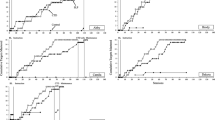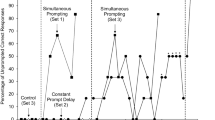Abstract
This investigation compared the effectiveness and efficiency (sessions, trials, percentage of errors, direct instructional time through criterion, and incidental information learned) of constant time delay and system of least prompts in teaching students with autism to name numerals. Two sessions were provided each day; one with constant time delay and one with system of least prompts. Two students learned 16 numerals, and one student did not learn any numerals with these two procedures. The parallel treatments design was used to assess the effects of the two instructional strategies. The results indicate that both procedures were effective in raising responding to criterion levels for two subjects. The constant time-delay procedure was more efficient than the system of least prompts procedure in terms of sessions, trials, percentage of errors, and direct instructional time through criterion.
Similar content being viewed by others
References
Barrera, R., & Sulzer-Azaroff, B. (1983). An alternating treatment comparison of oral and total communication training program with echolalic autistic children.Journal of Applied Behavior Analysis, 16, 379–394.
Bennett, D. L., Gast, D. L., Wolery, M., & Schuster, J. (1986). Time delay and system of leas prompts: A comparison in teaching manual sign production.Education and Training of the Mentally Retarded, 21, 117–129.
Billingsley, F., White, O. R., & Munson, R. (1980). Procedural reliability: A rationale and an example.Behavioral Assessment, 2, 229–241.
Breen, C., Haring, T., Pitts-Conway, V., & Gaylord-Ross, R. (1985). The training and generalization of social interaction during breaktime at two jobs sites in the natural environment.Journal of the Association for Persons with Severe Handicaps, 10, 41–50.
Charlop, M. H., Schreibman, L., & Thibodeau, M. G. (1985). Increasing spontaneous verbal responding in autistic children using a time-delay procedure.Journal of Applied Behavior Analysis, 18, 155–166.
Charlop, M. H., & Walsh, M. E. (1986). Increasing autistic children's spontaneous verbalizations of affection: An assessment of time delay and peer modeling procedures.Journal of Applied Behavior Analysis, 19, 307–314.
Duker, P. C., & Morsink, H. (1984). Acquisition and cross-setting generalization of manual signs with severely retarded individuals.Journal of Applied Behavior Analysis, 17, 93–103.
Gast, D. L., & Wolery, M. (in press). Parallel treatments design: A nested single subject design for comparing instructional procedures.Education and Treatment of Children.
Godby, S., Gast, D. L., & Wolery, M. (1987). A comparison of time delay and system of least prompts in teaching object identification.Research in Developmental Disabilities, 8, 283–305.
Handen, B. L., & Zane, T. (1987). Delayed prompting: A review of procedural variations and results.Research in Developmental Disabilities, 8, 307–330.
McIlvane, W. J., Withstandley, J. K., & Stoddard, L. T. (1984). Positive and negative stimulus relations in severely retarded individuals' conditional discrimination.Analysis and Intervention in Developmental Disabilities, 4, 235–251.
Smith, M. D., & Belcher, R. (1985). Teaching life skills to adults disabled by autism.Journal of Autism and Developmental Disabilities, 15, 163–175.
Tawney, J. W., & Gast, D. L. (1984).Single subject research in special education. Columbus, OH: Merrill.
Wolery, M., Ault, M. J., Doyle, P. M., & Gast, D. L. (1986).Comparison of instructional strategies: A literature review (U.S. Department of Education, Grant No. G008530197). Lexington, KY: Department of Special Education.
Wolery, M., & Gast, D. L. (1984). Effective and efficient procedures for the transfer of stimulus control.Topics in Early Childhood Special Education, 4, 52–77.
Wolery, M., Gast, D. L., Kirk, K. & Schuster, J. (1985). Fading extra-stimulus prompts with autistic children using time delay.Education and Treatment of Children, 11, 29–44.
Author information
Authors and Affiliations
Additional information
This investigation was supported by the U.S. Department of Education, grant G008530197. However, the opinions expressed do not necessarily reflect the policy of the U. S. Department of Education, and no official endorsement of the U.S. Department of Education should be inferred. The authors are grateful for the assistance provided by Donald Cross, Chairperson, Department of Special Education, University of Kentucky, and to Norman Osborne, Carl Spivey, and Florence Shifflett of Fayette County Public Schools. A more complete description of this study can be obtained from the authors.
Rights and permissions
About this article
Cite this article
Jones Ault, M., Wolery, M., Gast, D.L. et al. Comparison of response prompting procedures in teaching numeral identification to autistic subjects. J Autism Dev Disord 18, 627–636 (1988). https://doi.org/10.1007/BF02211880
Issue Date:
DOI: https://doi.org/10.1007/BF02211880




